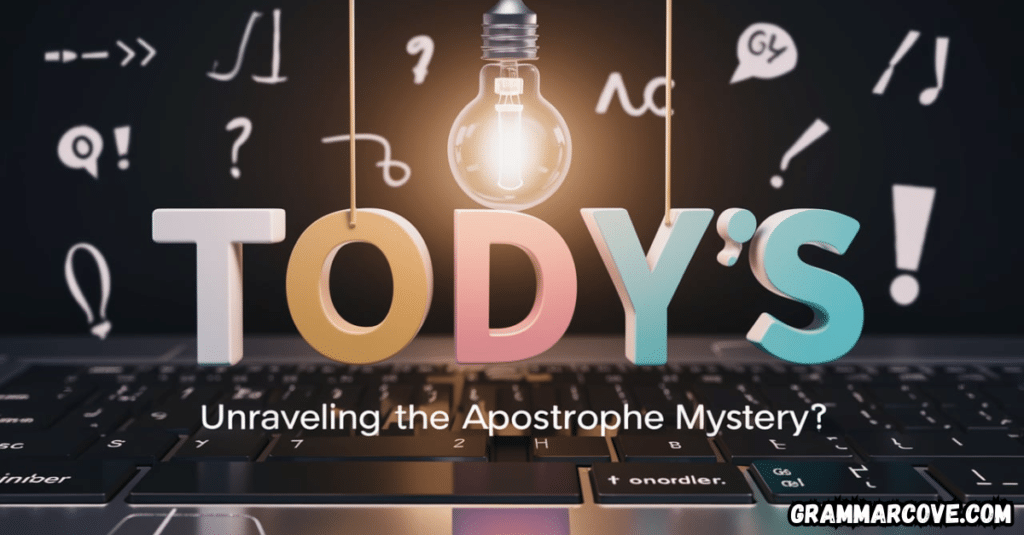Apostrophes are often a source of confusion for many English learners, especially when it comes to words like today’s vs. todays. At first glance, these two variations may seem like mere spelling differences, but they have distinct meanings and uses. Understanding the apostrophe rules in English can help clarify the correct use of today’s and avoid common grammar mistakes.
In this article, we will explore the rules surrounding possessive nouns like today’s, compare it with the plural form todays, and dive deep into the correct apostrophe usage. Along the way, we will highlight practical scenarios—such as emails and business writing—where these grammatical choices play a crucial role in communication.
The Basics: Singular vs. Plural Possessive Forms
Before we get into the difference between today’s and todays, it’s important to understand the concept of possessive vs. plural forms. An apostrophe can be used to show possession, but it also has a role in forming plurals.
Singular Possessive Form
When we use an apostrophe with a singular noun, it typically indicates possession. This is known as the singular possessive form. For example:
- Today’s meeting is important for the team.
- I’ll review today’s report later.
In these examples, today’s refers to something that belongs to or is associated with today.
Plural Form
On the other hand, when we refer to more than one “today,” we do not use an apostrophe. Instead, we simply add an “s.” This is the plural of today:
- We discussed the project during todays meetings.
- There were many changes in todays updates.
However, note that the plural form of today is quite rare. You typically wouldn’t say “todays meetings” unless you’re referring to several meetings happening over different days.

Correct Use of Today’s: When is the Apostrophe Needed?
The apostrophe in today’s is used to show possession. This could be possession of an event, an object, or even a moment in time.
For example, consider the following email to a colleague:
Subject: Today’s Deadline Update
Hi Mark,
I just wanted to remind you about today’s deadline for the report. Please make sure all sections are complete by 5 PM so we can meet the client’s expectations.
Let me know if you need any assistance!
Best,
John
In this example, today’s refers to the specific deadline associated with today. It’s a possessive form because the deadline belongs to today.
Common Apostrophe Errors to Watch Out For
Even native speakers of English often make mistakes with apostrophes. Some of the most common apostrophe errors involve confusion between the possessive and plural forms. Here are a few:
- Today’s meeting vs. Todays meeting: The first is correct because it shows possession (the meeting belongs to today). The second is incorrect because todays should not have an apostrophe in this context.
- Today’s updates vs. Todays updates: Again, the apostrophe is necessary in the first example to indicate that the updates belong to today.
How to Use Apostrophes: Understanding the Rules
There are several guidelines to follow when using apostrophes, especially in business or professional writing. Here are the key rules for apostrophe usage in English:
- To show possession: Use an apostrophe to indicate that something belongs to someone or something.
- Correct: Today’s agenda includes a detailed discussion of the budget.
- Incorrect: Todays agenda includes a detailed discussion of the budget.
- To show joint possession: When two or more people share ownership of something, the apostrophe is placed after the last person’s name.
- Example: John and Mary’s project is due today.
- To form plurals of letters, numbers, and abbreviations: Use an apostrophe when making plural forms of single letters or numbers.
- Example: Mind your p’s and q’s.
- Avoid using apostrophes for plural forms: Todays does not require an apostrophe. It’s just the plural of today.
Possessive Nouns Examples: Applying Apostrophe Rules
Let’s explore some more examples that show possessive nouns in various contexts:
Example 1: In Business Writing
Imagine you are sending an email to your team about an upcoming event:
Subject: Preparation for Today’s Event
Dear Team,
I hope you’re all ready for today’s product launch. As discussed earlier, we need to finalize the presentation and make sure everything is in place by 3 PM.
Please let me know if there are any last-minute changes to the agenda.
Best regards,
Sarah
In this case, today’s refers to something that belongs to today, which is the event. Notice how the apostrophe is essential here, showing ownership of the event by today.
Example 2: In Personal Correspondence
Consider a casual email about a weekend gathering:
Subject: Today’s BBQ
Hi Lisa,
I just wanted to let you know that today’s BBQ at my place starts at 4 PM. We’ll have burgers, drinks, and some music. Hope you can make it!
See you soon,
Tom
Here, today’s BBQ refers to the BBQ that is happening today, again using the apostrophe to show possession.
Difference Between Today’s and Todays: Clear Distinctions
The real mystery lies in understanding the difference between today’s and todays. As we’ve seen, today’s is a possessive form, while todays is simply a plural.
Here’s a quick breakdown:
| Form | Use | Example |
|---|---|---|
| Today’s | Possessive form, showing ownership or association | Today’s meeting starts at 2 PM. |
| Todays | Plural form, refers to multiple instances of today | The todays meetings were canceled. |
Grammar for Professionals: Ensuring Proper Usage
For professionals, correcting possessive mistakes is especially important. Whether you’re drafting emails, writing reports, or preparing presentations, your grammar reflects your professionalism.
A misplaced apostrophe can make your writing look careless. To ensure your work is polished, always review your use of apostrophes and other grammar rules. Here are some English writing tips to keep in mind:
- Proofread for common grammar mistakes: Look out for apostrophe misuse, as it’s an easy error to make.
- Use apostrophes only for possession: Avoid the temptation to add an apostrophe when making plurals.
- Consistency matters: Keep your apostrophe usage consistent across documents, especially in professional settings.
Writing Clear English Sentences: Avoiding Grammatical Errors
When you’re writing clear English sentences, it’s crucial to avoid grammatical errors like apostrophe misuse. To help with this, here’s a quick checklist to follow when using apostrophes:
- Is the word possessive? If it shows ownership or association, you need an apostrophe.
- Is the word plural? If it’s simply plural, don’t use an apostrophe.
- Are you referring to something specific to today? If so, use today’s.
Conclusion: Mastering Today’s Grammar Rules
In summary, understanding the correct usage of today’s is key to clear, professional writing. The apostrophe in today’s shows possession and tells your reader that something belongs to or is associated with today. On the other hand, todays is the plural form and should not include an apostrophe.
By following the rules for apostrophe usage in English, avoiding grammatical errors, and being mindful of possessive nouns examples, you can improve your writing and communicate with clarity. Whether you’re drafting a business email or writing a personal note, these insights will help you confidently navigate the apostrophe mystery.


